Free Influencer Marketing Series
Success! Enjoy the series! Part 1: How an agency took a brand from 0 to $1MM in 4 months using influencers & ads
Free Influencer Marketing Series
Success! Enjoy the series! Part 1: How an agency took a brand from 0 to $1MM in 4 months using influencers & ads

If your brand or agency is running influencer marketing campaigns, you need an influencer analytics tool as a part of your tech stack.
Influencer analytics tools make it easy to measure influencer marketing performance, find learnings in data, and drive better outcomes.
However, with so many tools offering influencer data analysis, how can you find the best one for your needs?
To help, we’ve created this comparison guide of the 14 best influencer analytics tools, who each is best for, their top features, and some pros and cons. Read on to learn more.
Note: Features and pricing are up-to-date as of this writing in April 2024, but are subject to change.
An influencer analytics tool is a type of influencer marketing software that provides performance measurement and impact of individual influencers and campaigns. This entails details like:
Media value
Total sales
Link clicks
The number of influencer content assets created
Types of content created
Total reach
Total engagement
Cost per engagement
Sales per influencer
Get an idea of what this could look like from MightyScout’s interface below:

Having data like this enables marketers to easily get an idea of what is working and not working, identify best performers, and make data-based decisions to continually improve their influencer marketing performance. That is how you can drive Return on Investment and prove the value of your efforts.
We mentioned how there are a number of influencer analytics tools available. And while we’re going to do a deep dive into the top 14, let’s cover some features you should be looking for.
This way, you can identify the most important features to your business as you sift through each of our recommendations.
A good analytics tool helps right from the start with the influencer selection process.
To choose influencers who can reach your target you need to review their audience insights. You may love the look and content of an influencer. But if 72% of their audience is in San Francisco and you’re trying to grow in New York City, then they’re not the right fit. Or if you’re trying to reach males, but 75% of their audience is female, then they’re not the right fit.
The audience insight report helps with this evaluation. See sample audience insights data from MightyScout below.

Brands and agencies can easily get information about influencers they may want to work with, like:
Engagement rate
Comments to likes ratio
Follower count
Number of posts
Average likes, comments and views per post
Take advantage of these insights while discovering and vetting influencers to compile the best possible list for your next campaign.
Take a look at this sample data from MightyScout:
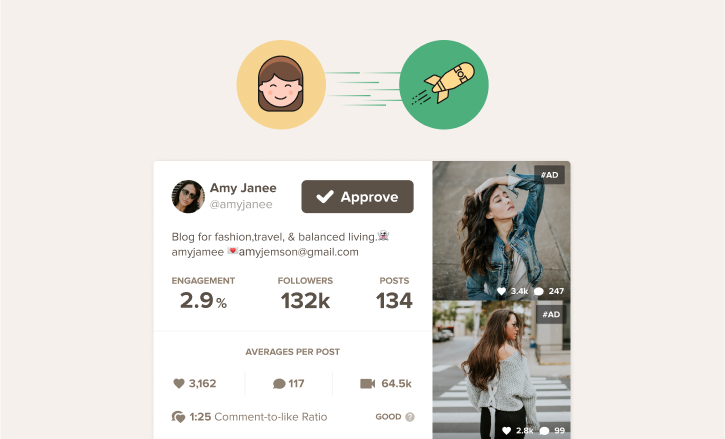
Fake followers can't buy your product. So your analytics tool should give insights into each influencer’s audience credibility. Here are some details you can get from MightyScout’s tool:
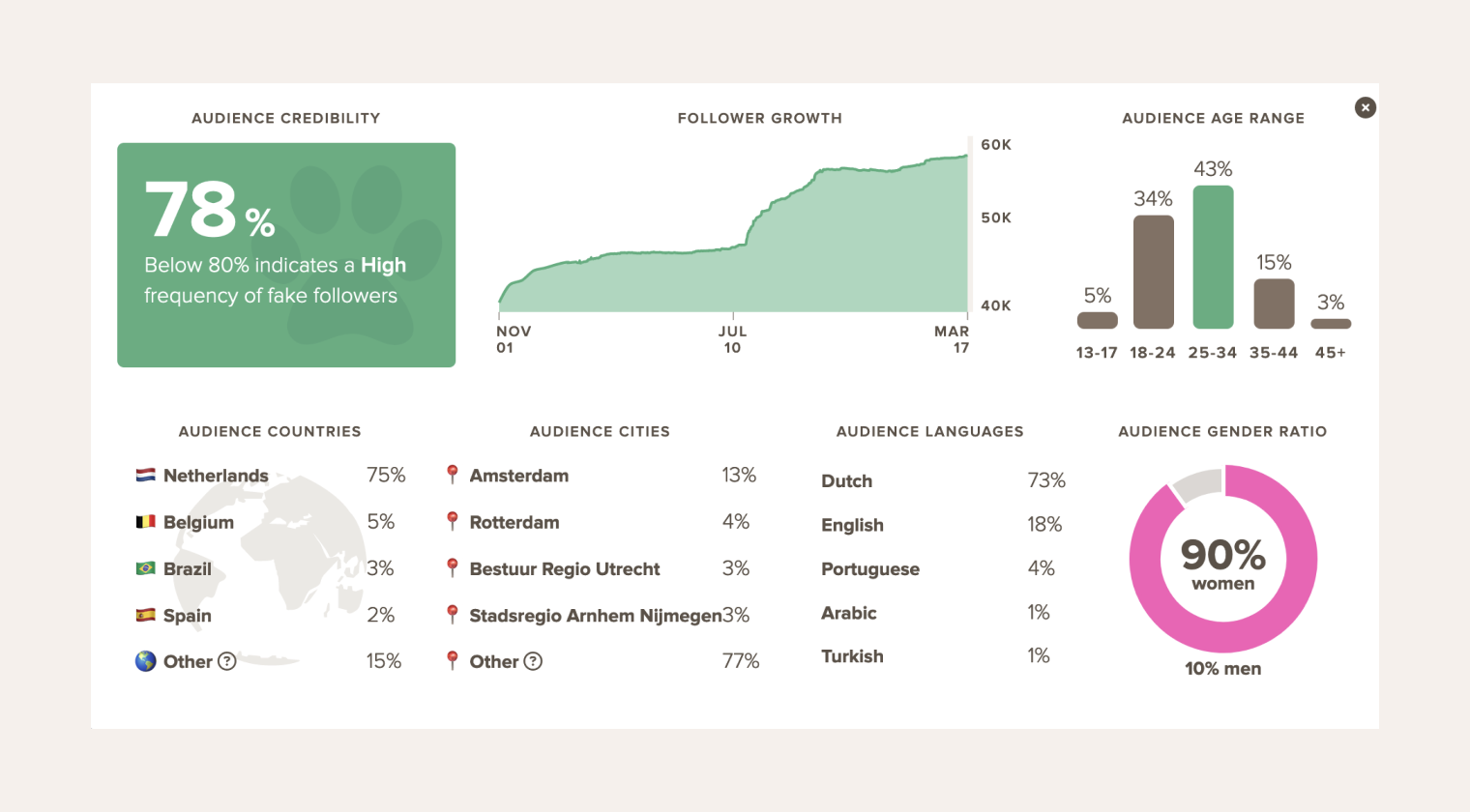
Not only does this help you align the influencer’s audience to your own, but your tool should also provide the ability to check for fake followers and fake/bot engagement on influencer accounts and during campaigns.
Once your campaign starts, an influencer analytics tool can help you monitor each influencer’s likes, comments, shares, and broader engagement rates after they’ve shared content. You can even analyze engagement through comment analysis.
Know which influencers generated the most engagement for your brand or client.
You can also review the most engaging posts, identify trends, and share tips and examples with future influencers on what works well.
Or sort by lowest "cost per engagement" to find influencers that generate engagement at the lowest cost.

Your analytics tool of choice should also be able to track and measure your overall campaign performance, showcasing metrics like reach, impressions, and engagement for awareness-based campaigns.
Make sure you can dive deep into both individual influencer posts as well as your campaign performance as a whole. What would your ideal campaign report look like? Take some ideas from our campaign report template. Some tools allow you to sort influencer content by metric and to see the influencer’s content in the analytics dashboards.
Justify your budget and performance, and ask for more, by showing your business impact in the language that matters to decision-makers.
To do this, your analytics tool must integrate with your e-commerce or marketing platform to track direct sales, lead generation, or other key conversion metric.
Here’s an example of what that can look like:
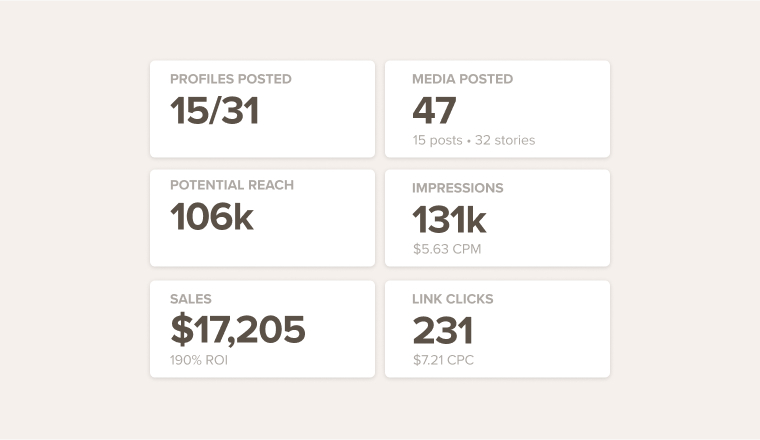
Agencies with multiple clients need the ability to connect multiple client accounts to a single tool. Some tools make multi-account work easier than others. For example, can you toggle between client portals or do you need to log out and log back in for each client. Ask about agency-friendly features.
Who wants to log into their new analytics tool, only to be met with a complex and difficult user interface (UI)? Short answer: nobody.
Make sure the tool you choose has an easy to use, clear, fast, and friendly user interface that makes checking and monitoring influencer analytics and campaign performance easy. Some analytics tools offer trials before you sign up so you can make sure the inner workings of the tool will be simple for your team to use. If not, be sure to check reviews about ease of use.
Integrations help make marketing processes easier. Make sure your analytics tool can easily integrate with other tools that are a part of your tech stack. This could include your other marketing tools, CRM, e-commerce platform, etc. MightyScout integrates with Shopify and WooCommerce making it easy to pull in sales data for your analytics and ROI.
If you’re adding a new piece of software, make sure it has a solid customer support team. Ideally, you won’t need them. But if you do, you want them to be responsive, timely, and helpful every single time you reach out. Find out when support is available and how it's offered (e.g., can you get an answer in minutes or will they respond within 24 hours?). Do you normally work after hours? Is support available then?
Finally, pay attention to pricing. Each analytics tool will offer different pricing structures, so make sure you select a tool that has a pricing model that fits your needs, is non-restrictive, and has multiple options to choose from.
Best influencer analytics tool for agencies managing multiple clients. Also easy to use for individual brands.

MightyScout is an influencer management and analytics tool that helps brands and agencies build, manage, and monitor successful influencer marketing campaigns. However, one of its bread and butter features is its analytics.
To ensure marketers can select the best influencers and seamlessly measure their results, MightyScout offers analytics to assist in influencer selection (e.g., like audience insights and past performance metrics) and analytics to evaluate how each influencer performed in your campaign and total campaign performance.
Easily monitor campaigns while also being able to compile reports, export them, and present customized findings to your client, team, or higher-ups.
Agencies can house all brands and influencers in one place for easy access, rather than having multiple accounts to log in and out of. Let MightyScout do the hard work of tracking all of your influencers’ content and progress so all you have to do is sit back, watch the results come in, and enjoy the reach, engagement, clicks, and sales each promotion brings your business.
Don’t take our word for it. Check out this case study from Bolt, whose team was able to save hours of time each week. Mykhailo Kudla, Bolt’s marketing partnerships lead, said, “We used to spend 6-8 hours before, now it takes 10-15 minutes.”
Influencer audience and performance insights
Self-updating analytics
Stories tracking
Product gifting, seeding and influencer events content tracking
Reporting + exportable reports
Multi-brand support
Intuitive interface
Strong tracking capabilities lead to complete and accurate analytics
Affordable and flexible pricing
Simplicity and ease-of-use with little to no training time needed
Multi-account management made easy
24/7 workday support
Not an all-in-one influencer management solution
Does not offer automatic influencer payments
Does not whitelist
Pricing: Starts at $99/mo and can be seen here.
Best for an all-in-one influencer marketing solution.

GRIN is a well-known influencer marketing tool that offers a number of features—as well as an arsenal of completely free tools for marketers to take advantage of. GRIN also offers a Google Chrome extension that can help brands to find and analyze influencers right on their social media platforms.
In addition, GRIN has robust reporting and analytics tools so that brands can easily monitor and assess their campaign performance. Access real-time data, metrics like ROI, and more with GRIN.
Automated, real-time analytics
KPIs like ROI, reach, engagement, etc.
Reporting capabilities
Intuitive dashboard
Easy-to-use all-in-one influencer marketing solution
Integrate with your ecommerce tool and other software
Manage your entire influencer marketing campaign with one tool
Free tools that can be used to find and compare influencers
Reporting and analytics aren’t as robust as a platform that focuses more on analytics than overall management
Does not track all influencer content so analytics may not show the full picture
Requires long-term contractual commitment. Impressions and other metrics can be hard to measure
Does not track influencer event content.
Pricing: Custom pricing upon request.
Best for companies looking for a hands-off approach.

Aspire is a full-scale influencer marketing platform that also offers agency services for companies looking to be completely uninvolved in their influencer marketing strategy implementation. Brands can pick and choose the level of involvement they want—whether they just want the help of Aspire’s software, or if they want an agency account manager to take over.
As far as analytics and reporting, Aspire offers a comprehensive dashboard for users to see their results as well as the ability to compile reports. Aspire also helps customers with affiliate marketing and ambassador marketing.
Affiliate tracking
Influencer marketplace
Campaign overview dashboard
Content measurement
Robust software for all influencer marketing needs
An agency to lean on for help working with influencers
A number of integrations to seamlessly fit into your tech stack
More expensive than the average influencer analytics tool
Must commit to a demo to find out pricing information
Pricing: Custom pricing upon request.
Best for lifestyle brands.
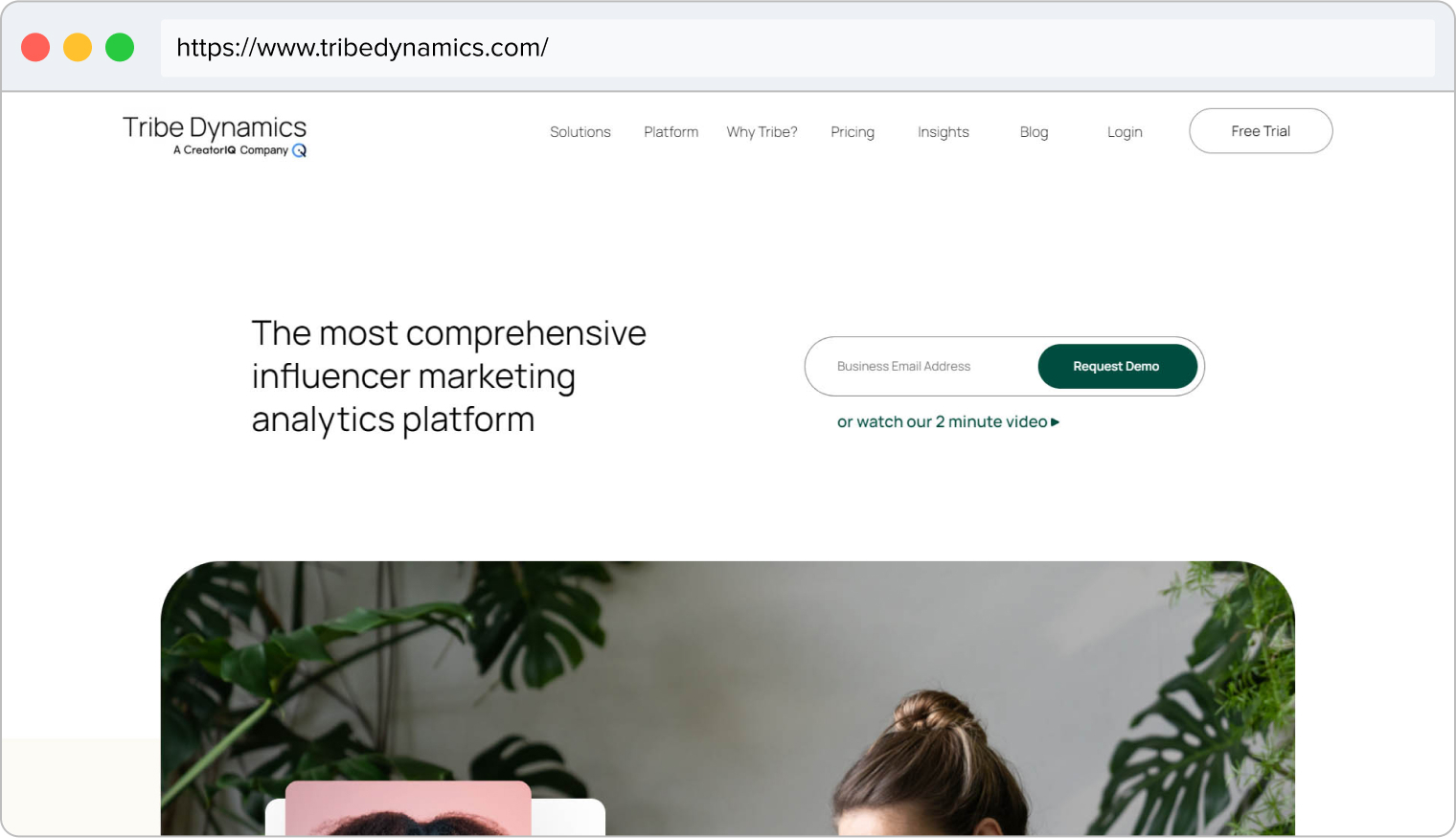
TribeDynamics is an influencer marketing analytics program that is part of the CreatorIQ umbrella. According to its own messaging, the platform was created specifically for lifestyle brands, making it the perfect tool for that niche to use for influencer marketing, discovery, and analytics.
With TribeDynamics, brands can easily find influencers with proven track records, analyze their influencer campaign performance, and access benchmark data to compare your brand to competitors and others in your industry.
Post-by-post tracking metrics
Competitor benchmarking
Earned media value (EMV) tracking
Influencer data
Data benchmarking to make sure your campaigns stand up to the competition
Narrow down your influencer partners with historical post and engagement data
Get in-depth post-by-post insights throughout your campaign
Impressions and other metrics can be hard to measure
24 hour waiting period to see media pulled in to the platform
Pricing is not agency-friendly.
Pricing: Custom pricing available upon request.
Best for Sprout Social users.

Tagger is an influencer analytics tool that was recently acquired by social media management tool Sprout Social. While many brands may benefit from its features, companies that already have Sprout Social as a part of their marketing tech stack may find it most useful as it will seamlessly fit into their tool belt.
Tagger offers a Content Health dashboard to give brands insight into historical influencer data, an Affinity engine for generating lists of relevant influencers, a custom report builder, and more.
Content health dashboard
Affinity engine
Report builder
Link tracking
Ethical data sourcing so brands know their data is coming from a safe place
UTM and pixel tracking so you can easily track results from your influencer posts
Get access to sleek report templates for visually appealing custom reports
Not an all-in-one influencer management software option
Impressions and other metrics can be hard to measure
Not strong at Stories tracking
Must commit to a demo to find out pricing information
Pricing: Custom pricing available upon request.
Best for brands looking to work with well-known influencers.

Julius is another influencer marketing and analytics tool available for brands to work with. One of Julius’s main selling points is that it has a hands-on team of analysts that builds out influencer profiles so customers are seeing more than just basic data points.
However, this USP is also one of its biggest hindrances as that means its database is limited, only filled with influencers that may be easy to find or well-known, and it’s automatically updated with information changes.
Influencer discovery platform
Influencer post search capabilities
Campaign workflows
Analytics dashboard
Brands can search through past influencer posts to ensure their content aligns with their brand
Get a bird's eye view of your campaign performance analytics in an easy-to-use dashboard
Easily export CSV reports to share with your team
All influencers are manually input into the system, meaning the database is limited and information can be outdated
Not strong at Stories tracking
Must commit to a demo to find out pricing information
Pricing: Custom pricing available upon request.
Best for brands interested in experimenting with AI but for whom Stories analytics are not important.

HypeAuditor is an AI-powered influencer marketing platform that takes advantage of artificial intelligence to provide influencer audience demographics, follower authenticity, and more.
The tool has millions of influencer profiles with thousands of new influencers discovered and added every day. The tool can always scan for updated information to help ensure influencer data is up-to-date.
Artificial intelligence assistance
Influencer audience quality scoring
Competitor analysis
Influencer account analysis
Campaign KPI tracking
Get access to more than 154 million influencers for your campaigns
Monitor more than 35 different metrics throughout your influencer marketing campaigns
Check out competitor campaigns to make sure your performance matches up
Many users report bugs and glitches while using the software
No Stories tracking makes it not a fit for conversion-focused brands
Must commit to a demo to find out pricing information
Pricing: Custom pricing available upon request.
Best for brands open to a long term commitment.

Upfluence is a well-known influencer marketing and analytics platform that helps brands find, manage, and analyze influencers and their performance. Upfluence offers flexible pricing so you’re only paying for what you need—but you must sign up for a minimum of 12 months right off the bat.
This means you need to be sure Upfluence is the right tool for you, and your team will be utilizing the software enough to make the full year worth it.
Influencer database
Influencer analytics
Campaign analytics
Check out data-rich influencer profiles to find the best partners
Find all influencer content in one easy-to-navigate campaign dashboard
Compile exportable reports to share with your team
Influencer database size is small compared to competitors
Must commit to a minimum of 12 months at signup
Must commit to a demo to find out pricing information
Pricing: Custom pricing available upon request.
Best for brands that want to pick and choose features they need.

Influencity is another tool with transparent pricing—and they have a custom bundling option that can work well for brands that need a flexible tool that can seamlessly fit into their existing process. While Influencity offers three different tiered plans, you might not need everything involved.
In that case, you can pick and choose the features you want to use and pay for using Influencity’s “Create Your Own Bundle” pricing option. This way, if you only use one feature for your influencer marketing strategy, you’re only paying for that one platform.
Influencer analysis for selection purposes
Results forecasting
Campaign reports
The ability to create your own feature bundle to get a more affordable price point
200M+ global influencer profiles to find your best influencer partners
Dashboard holding all results and KPIs in one space
Its full-service options are on the more expensive side
Lack of automated influencer tracking impacts the completeness and the accuracy of analytics
Paid plans come with limited monthly analyses, results, and lists
Pricing:
Basic: $168/month
Professional: $348/month
Business: $698/month
Create Your Own Bundle: Custom pricing
Best for brands that already use Keyhole as a social media tool.
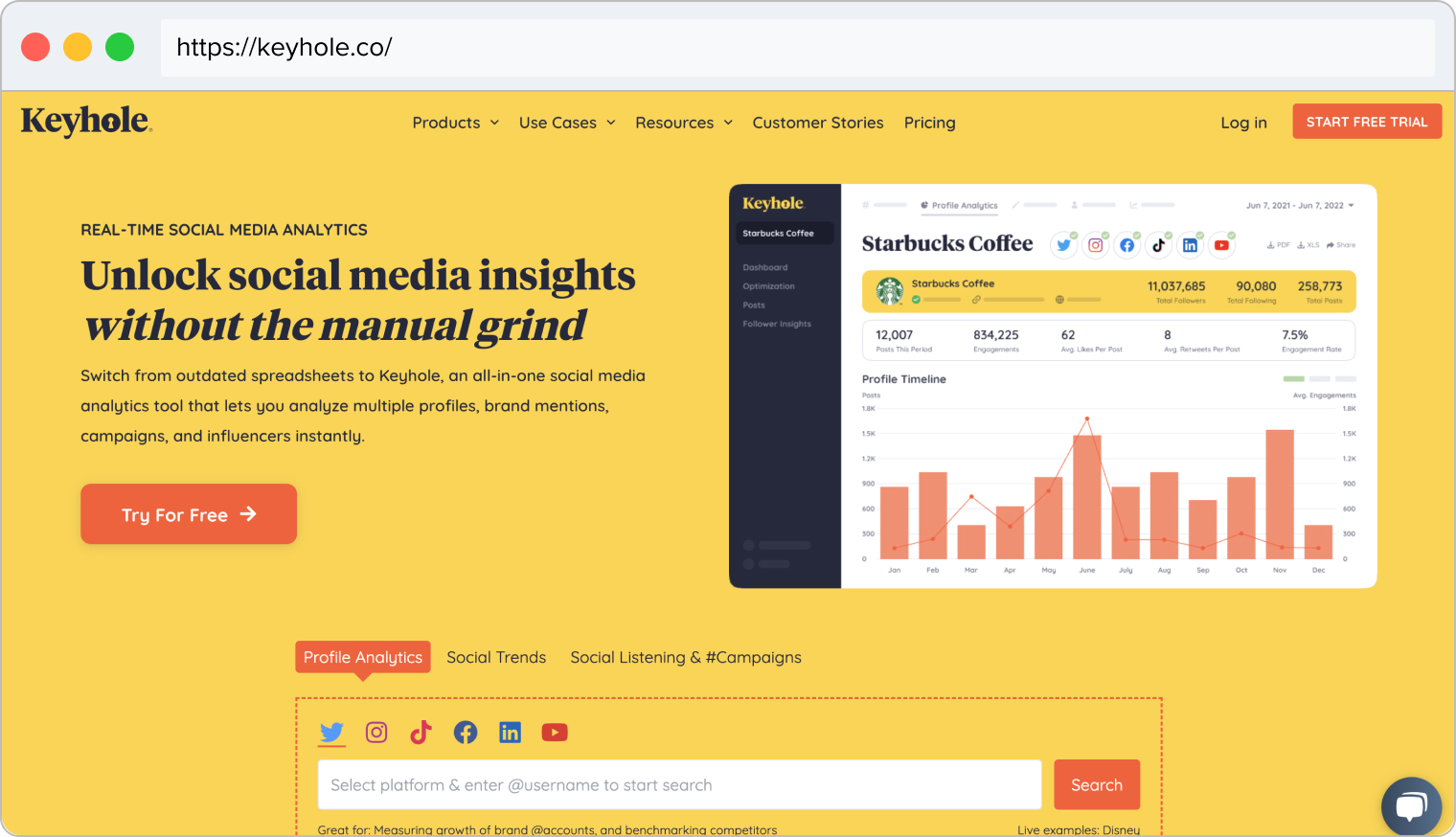
Keyhole is a social media analytics and reporting tool that also offers some influence marketing features. This means brands can use Keyhole to support influencer discovery and check the performance of influencer marketing campaigns. Notably, Keyhole does not track TikTok influencers or content.
With Keyhole, brands can publish social media content, keep an eye on trends, analyze their social media performance, and track their influencer posts, excluding TikTok.
Profile analytics
Historical data
Influencer tracking
Automated reporting
Find influencers that are highly relevant to your industry with hashtags and filters
Get access to each influencer’s contribution to your campaign’s overall ROI
Take advantage of optimization tips from Keyhole that can help influencers improve their post performance
Not an all-in-one influencer management solution. Purpose built for social media, not influencer marketing.
Expensive for what users get
Does not track TikTok influencers or capture TikTok content
Pricing:
Individual: $89/month
Team: $189/month
Pro: $259/month
Advanced: $549/month
Enterprise: $833/month
Campaign: Custom pricing
Best for brands that don’t need to conduct a widespread influencer search.
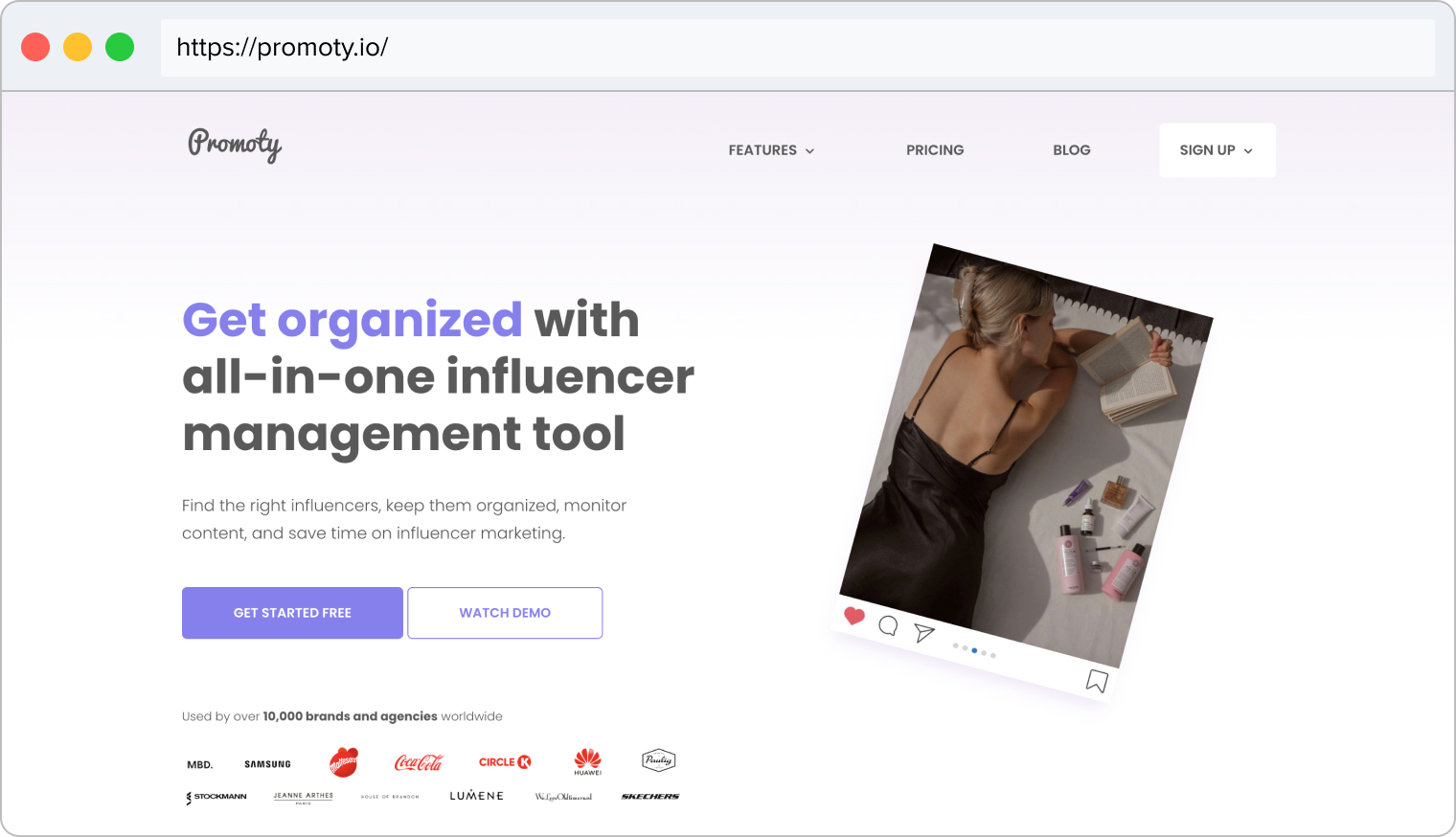
Promoty is a useful influencer analytics tool, although its influencer management features are on a much smaller scale. Promoty is perfect for smaller brands that either know what they want in an influencer or don’t need to conduct a huge search.
This is because Promoty’s influencer search features are credit-based, and each tiered plan comes with a different number of credits. Once your credits are up for the month, you aren’t able to search for any additional influencers.
Influencer profile analytics
Hashtag analysis
Influencer credibility details
Influencer content tracking
All-in-one tool for finding, managing, and analyzing influencers
Get detailed reports for each influencer you’re considering working with
Make sure the influencers you want to partner with are credible
Not as robust of a tool as other options on this list
Plans come with limited credits for influencer search and discovery
Pricing
Basic: $132/month
Professional: $179/month
Expert: $272/month
Enterprise: $687/month
Best for brands on a budget.

Social Status is a social media analytics tool that also offers an influencer analytics set of features. Due to its smaller feature offerings, it’s a much more affordable tool. If you’re looking specifically for analytics and not an all-in-one solution, Social Status may fit your budget well.
Get access to basic influencer follower demographics, then track content and performance throughout your campaign. You can then build out an exportable report to share with your team.
Influencer follower demographics
Engagement rate comparisons
Analytics dashboard
Reporting
Get access to useful influencer analytics for an affordable price point
Dashboard to aggregate all posts and stories and monitor performance in one place
Access influencer follower demographics and engagement rate
Not nearly as robust as other tools on this list
Outdated dashboard interface design
Pricing: Free plan—does not come with influencer analytics features
Micro: $9/month
Starter: $29/month
Pro: $49/month
Business: $99/month
Agency: $199/month
Best for Later social media management users.

Later Influence is another social media management tool that has recently added influencer marketing capabilities. With that in mind, Later’s influencer analytics features are best for brands that are already using Later for social media analysis.
With Later, brands can find influencers, manage influencer campaigns, pay influencers, and analyze campaign performance. Get access to predictive performance features as well as automatic reporting.
Influencer profile analysis
Report automation
Conversion tracking
Predictive performance forecasting
Get access to predictive results forecasting to estimate campaign performance with your group of influencers
All-in-one solution for social media marketing and influencer marketing
Real-time campaign tracking and reporting
Takes some learning and training time to figure out
Does not automate influencer tracking for YouTube Videos and Shorts. It's TikTok tracking requires some manual work.
Only around 10 million influencers in their database
Must commit to a demo to find out pricing information
Pricing: Custom pricing available upon request.
Best for brands looking to scale their influencer marketing.

Traackr is an all-in-one influencer marketing and analytics software that also offers tools and features specifically for large brands looking to scale their influencer marketing efforts. Though the tool touts that it works well for small companies too, it’s catered towards larger companies with larger budgets.
Get access to helpful features for every aspect of influencer marketing with Traackr, from influencer profile analytics to content tracking and more.
Data-driven influencer insights
Automated content tracking
ROI measuring
Benchmarking
All-in-one solution for brands looking for a software that does everything
Evaluate individual performance to see which influencers made the biggest impact
Benchmark your results against other channels and markets
Not the best tool for smaller teams with smaller budgets
Must commit to a demo to find out pricing information
Tracking delays for unregistered influencers
Pricing: Custom pricing available upon request.
Now that we’ve covered the 14 best options out there, it’s time to figure out which one is going to be the best for your business. Use these tips to evaluate the different influencer analytics tools and choose the best option for your brand or agency.
First things first, decide if you're at the point of needing to outsource analytics. If you’re only running small-scale influencer marketing campaigns with no plans to scale, you may not need to invest in an analytics tool yet.
However, if you’re struggling with reporting, have plans to scale your influencer campaigns, and have the budget to bring on a new tool, it’s the perfect time to get started.
What do you absolutely need in an analytics tool? If you already have an influencer discovery process, you may not care about influencer audience and engagement insights.
And on the other hand, you might be looking specifically for a tool that can help you calculate your overall return on investment.
If Stories, product seeding, gifting or influencer events are important to your analytics, some tools have limitations.
Think about your must-haves as well as the things you don't really need. This can help you narrow down your choices.
If you’re not sure about your must-haves, then think about your biggest pain points. What blind spots do you have in your analytics right now? Where are you struggling? What is a specific metric that your higher-ups have been asking for but you haven’t yet been able to deliver?
Keep these in mind and see if you can find an analytics tool that can provide you with all of the details you’ve been missing in past campaigns.
Keep this checklist on hand as you search for the right tool:
How complex are our influencer marketing campaigns?
What is our budget for an influencer analytics tool?
Do we need an influencer analytics tool to integrate with our current marketing stack or ecommerce tool??
What’s the skill and experience level of members on the team?
How important is ease-of-use and speed to get started?
What specific influencer analytics data and metrics are most important to us?
Do we need real-time or daily analytics?
Do we only need a stand-alone tool or is an all-in-one okay?
What level of customer support will we need?
Do we need a tool that can help us scale?
Do we need a tool that can scale with us?
Figure out which influencer analytics tool will be best for your influencer marketing needs? Many of these tools offer demos or free trials to help you get the full scope of how it can help.
If you’re considering MightyScout, book a demo with team today to learn how we can help. Our influencer analytics tool is robust, easy-to-use, and affordable.

Join hundreds of organizations who use MightyScout everyday with our 14-Day Trial. No credit card needed.